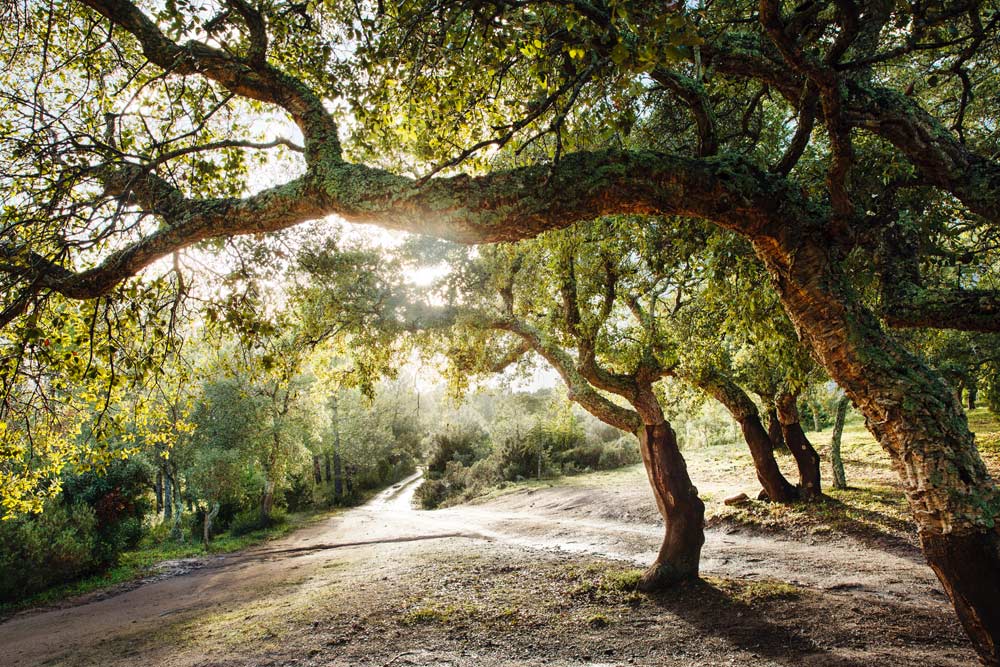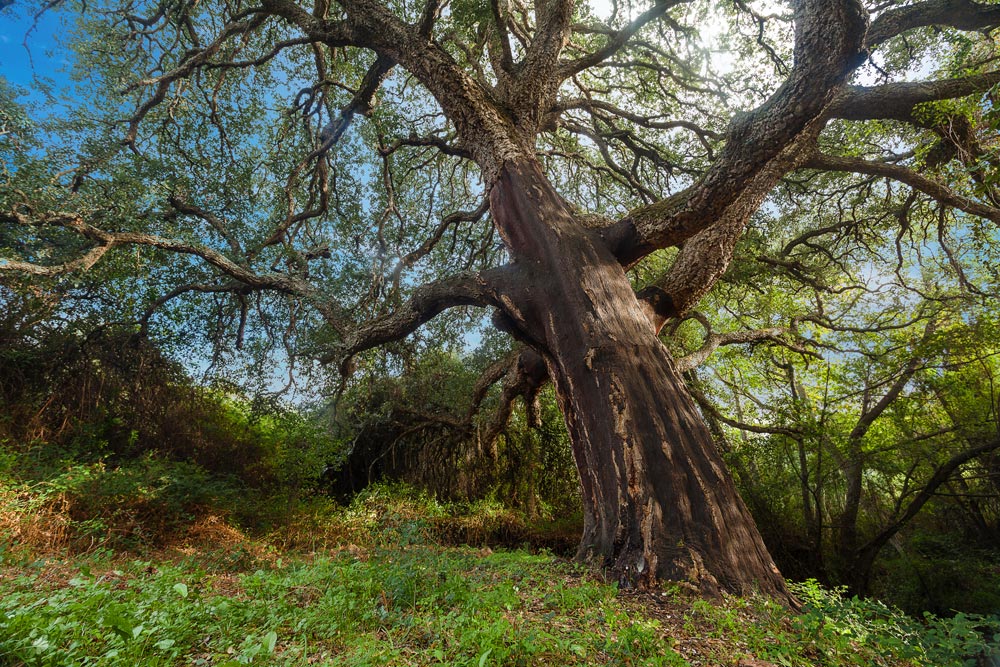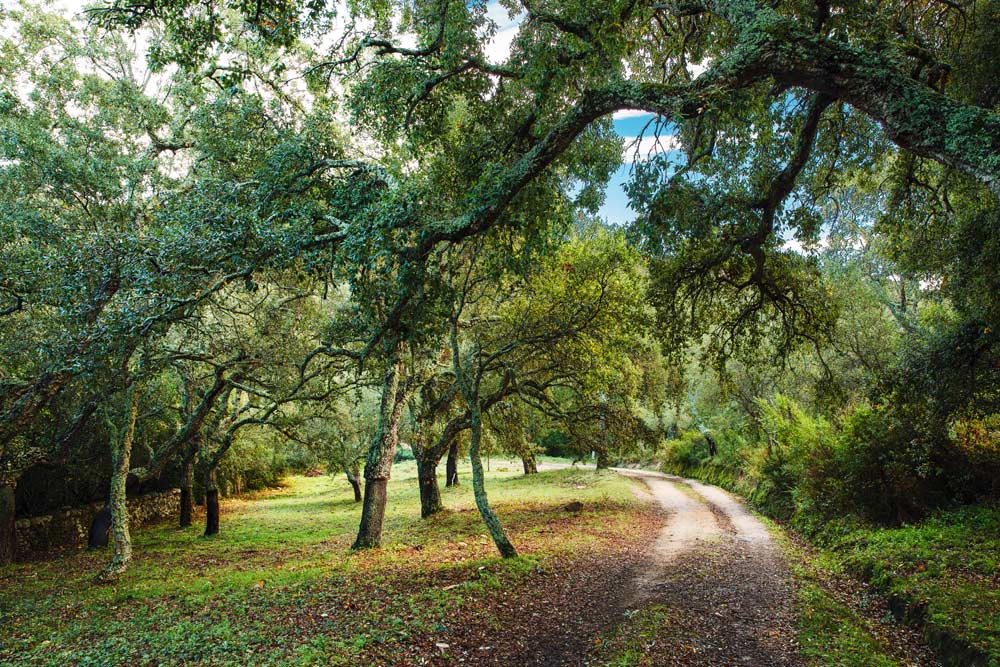


There is a precious commodity that is abundantly found in Gallura: cork.
It is a material that is extracted from the quercus suber, otherwise known as cork oak. It is the outer covering of the plant, with particular porous and elastic characteristics, used over centuries by mankind for different reasons.
It is one of our most important natural resources. It is important to know that there are no oak plantations, and all the cork that is produced today derives from spontaneous natural cork or come from the commitment of mankind, who over time has selected this plant among many, to the detriment of others, such as the holm oak, protecting it and renewing it, with full respect for the landscape.
The cork oak, which is one of the characteristic plants of the Mediterranean scrub, characterizes the landscape of the whole of northern Sardinia and of different wooded areas of the island. It is a plant spontaneous and resistant to the climate of Sardinia: cold and windy in winter, hot and dry in summer.
The hills of Gallura are characterized by the presence of the cork oak, more familiarly called "sughera". There are cork trees that extend over several hectares giving life, together with cistus, myrtle, strawberry trees and other varieties of shrubs, to the green landscape of northern Sardinia that stands out from other areas of the island for its vigor.
The cork woods alternate with small rocky mountains, fields of hay, cattle breeding and vineyards and represent an important habitat for different varieties of birds and animals, such as wild boar, foxes and rabbits. In autumn various types of mushrooms grow, such as porcini, ova and field mushrooms, offering a unique and protected biodiversity.
In Gallura there are several ancient oaks. For example, the monumental cork oak tree of Crisciuleddu still exists. If you want to admire it you can easily reach it from the road that leads from the village of Luogosanto to Aglientu, a few meters away from a country road.

Mankind understood that cork was a versatile material that could be used in different ways, above all thanks to its easy workability. Over time the processing of this material has become specialized and the various stages of treatment give life to a real craft and industrial sector, important for the local economy, which culminated at the end of the last century.
Our ancestors learned to extract and process the cork, ensuring respect for the environment and the landscape. Bear in mind that in order to extract the cork the plant is neither cut nor suffers. On the contrary, the cork oak is a very resistant plant and will reproduce again the cork once it is extracted. There is no need for specific treatments of the soil or the plant: the cork grows by itself, it is a gift of nature.
This is another advantage of cork: it is a renewable material. It takes 10 years for the plant to reproduce a layer of cork that can be re-extracted. The growth of cork is influenced by several factors, first of all the climate, but this is the minimum time necessary for the recreation of a cork layer suitable for processing.
The first phase is that of extraction, which takes place only in the summer period from May to August. It is a delicate moment for the plant because it requires a lot of attention and experience. Lu bucadòri is the ‘scorzino’ (the name of someone who removes cork from the tree), the one who takes care of extracting the cork: they cut the bark with the blade of a special axe called the piola and continues by slowly removing the cork into large slabs, usually two or three.
The first extraction is carried out on a plant that is at least 20 years old. This process is called ‘demaschiatura’, which is the extraction of the first layer of cork, referred to as ‘maschio’ (male), as it is more rough and irregular, while the subsequent layers of cork will be ‘femmine’(females) with a smoother and regular surface.
Once collected, the cork is kept in open air in courtyards. Subsequently it is boiled in water at a temperature of 100°C. This process, besides disinfecting the cork and eliminating the bacteria, allows the cork slabs to lose their normal curvature and become flat and therefore easier to work with.
Once cooled and dried at room temperature, the cork is ready to be worked and cut into strips according to the product it will be made into.

One of the most important products obtained from cork is undoubtedly the bottle stopper. Once handcrafted with simple tools, cutting the cork into a ‘small square’, or a small parallelelepiped, in more recent times the process has been replaced with industrial machines that can extract the cork faster. Among these the fustélla is a machine that cuts cork stoppers directly from horizontal cork strips.
There are different types of cork. From one made entirely from a single piece of cork to that made of powder and residues, which are less expensive than the former.
To produce a cork stopper, it is necessary to cut the cork slab into strips (called ‘bands’) of a thickness equal to that of a cork stopper.
Once the stopper is produced, the paraffin-refining phase is carried out, which allows the stopper to be protected and bottled.
Cork is also used in buildings as an insulator in walls and roofs, but also as a fabric.
In recent times, cork has been transformed into a soft material suitable for making clothes and accessories.
The creativity of different artisans has had its effect on bags and clutches of different shapes that make use of the normal texture of cork as a decorated fabric. Such accessories are often made using other materials such as leather and fabrics and embroidering flowers, animals and decorations on them. Skirts, shawls and formal dresses are also made with cork.
The same fabric is also used to make sofas and beds for refined and luxurious furnishings.
In the past, cork was used to make containers for food and beverages, ladles for water, trays, as well as other materials. Cork is a common object, used as home decoration and in nativity scenes. The male cork is used to simulate mountains while pieces of cork are used to make houses and walls.
In Luogosanto the Lacu Artisan Workshop by Antonello Solinas works cork to create nativity scenes inspired by the village of Luogosanto and the stazzi (typical Sardinian housing) of Gallura.
The workshop also makes baskets, side dishes and custom made trays. It can be visited on request and the products can be purchased at the Tourist Office of Luogosanto in Piazza della Basilica, 2.
Nowadays cork is still a natural material offered spontaneously by nature without the need for cultivation or treatments, suitable for different uses, while simultaneously versatile, ecological, reusable and always trendy.
Share on Social Media